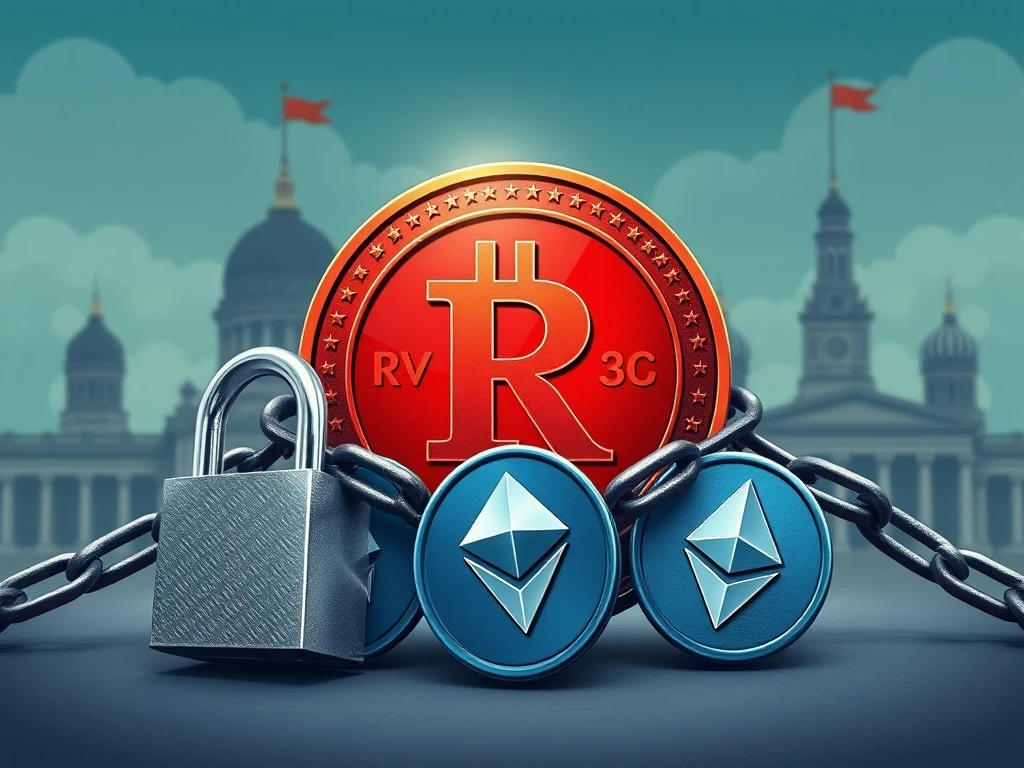Russia’s Drastic Crypto Regulations Intensify as Digital Ruble Nears 2026 Launch

The world of cryptocurrency is no stranger to regulatory shifts, but Russia’s latest moves are sending shockwaves, especially for those involved in crypto transactions Russia. As the nation gears up for the digital ruble launch in 2026, a sweeping crackdown on decentralized digital assets is underway, fundamentally reshaping how individuals and businesses interact with crypto.
What Do Russia’s New Crypto Regulations Mean for You?
The Russian government is tightening its grip on the digital asset landscape, signaling a clear shift towards centralized financial control. New laws and amendments, including revisions to the “National Payment System” law and anti-money laundering provisions, grant banks unprecedented power.
These stringent Russia crypto regulations are designed to monitor and restrict cryptocurrency activities, aligning with the government’s broader goal of establishing a more centralized financial system. The Central Bank of Russia (CBR) has also directed commercial banks to impose stricter scrutiny on crypto-related transfers, including setting monthly transaction limits and blocking cash deposits. This means your routine crypto transactions Russia could be under the microscope.
Key Regulatory Powers Granted to Banks:
- Account Freezing: Banks can now freeze accounts linked to suspicious crypto activities.
- P2P Penalties: Peer-to-peer (P2P) crypto trades face severe penalties.
- Criminal Charges: Individuals involved in illicit transactions could face criminal charges.
Under the revised “National Payment System” law, banks can restrict or completely block access to financial services if accounts are flagged for suspicious activity. This includes transactions involving cryptocurrency exchanges, P2P swaps, or any transfers linked to fraud, money laundering, or online gambling. Partial restrictions prevent users from accessing specific banking tools, while full blocks cut off all financial services across institutions.
Navigating the Perilous Path of Crypto Transactions in Russia
Legal analysts warn that even ordinary crypto users could inadvertently fall into “high-risk” categories simply by engaging in routine trades or selling digital assets for fiat through online platforms. The government’s crackdown also extends to legislative amendments targeting “droppers” and “money mules,” terms used for individuals whose accounts are exploited for laundering. Critics argue these provisions disproportionately affect legitimate crypto traders, as even valid transactions might trigger investigations if linked to flagged transfers.
The CBR reinforced these measures in June, urging banks to “swiftly identify” crypto-related activity, further complicating cross-border payments and domestic exchanges. This environment necessitates extreme caution for anyone engaging in crypto transactions Russia, as the line between legitimate and illicit activity is becoming increasingly blurred from the regulators’ perspective.
The Digital Ruble’s Ascent and Sanctions Evasion Crypto
While cracking down on decentralized crypto, Russia is aggressively advancing its state-backed financial infrastructure. The digital ruble launch, set to begin phases on September 1, 2026, aims to provide a government-sanctioned alternative to decentralized cryptocurrencies. This central bank digital currency (CBDC) is envisioned to offer greater control and transparency for the state.
The CBR has also introduced a universal QR code for payments, explicitly banning the use of Bitcoin and other digital assets for goods and services under the 2021 “Digital Financial Assets” law. This exclusion applies to all but a narrow “experimental legal regime” for foreign trade, which allows some companies to bypass Western sanctions via crypto.
Paradoxically, the government is also promoting sanctioned crypto alternatives. A7A5, a ruble-pegged stablecoin backed by Promsvyazbank (a bank under Western sanctions), was launched in February 2025 to facilitate international transactions while enabling sanctions evasion crypto. Though not yet widely adopted, A7A5 reflects a strategic effort to reduce reliance on major crypto firms like Tether, which cooperate with U.S. and European regulators. The rise of such alternatives underscores Russia’s dual approach: restricting domestic crypto use while fostering sanctioned projects to sustain its financial independence.
Russian Crypto Mining and Domestic Activity Surge Despite Curbs
Despite the intensified crackdown on crypto transactions Russia, domestic crypto activity is expanding. The number of officially registered Russian crypto mining companies surged from 91 in early 2024 to over 1,000 by mid-2025, according to a Moscow lawmaker. This growth indicates a robust, albeit increasingly regulated, mining sector within the country.
The CBR has responded by approving mutual funds offering crypto investments, aiming to channel retail participation into regulated channels. This contrasts sharply with the closure of major platforms like Garantex earlier this year, following Tether’s block on $28 million in USDT transactions linked to the exchange. This shows a complex, dual approach: suppressing unregulated use while attempting to control and benefit from regulated avenues, particularly in the realm of Russian crypto mining.
Geopolitical Tensions and the Future of Crypto in Russia
Legal pressures are intensifying for individuals, as seen with a U.S. federal court seeking a 15-month prison sentence for a Russian national convicted of manipulating crypto markets. This highlights Washington’s focus on holding Russian actors accountable for financial crimes.
Moscow’s broader regulatory strategy aligns with ongoing geopolitical tensions, as the U.S. and EU expand sanctions targeting Russia’s economy and evasion efforts. The government’s balancing act—suppressing domestic crypto use while promoting sanctioned alternatives—reflects its struggle to adapt to a fragmented global financial landscape.
As the digital ruble launch nears, the regulatory environment is likely to remain volatile, with traders navigating both punitive measures and emerging opportunities in state-sanctioned crypto infrastructure. The interplay between domestic regulation, international sanctions, and the development of a state-backed digital currency will define the future of crypto in Russia.
Conclusion
Russia’s stringent new crypto regulations mark a pivotal moment in the global digital asset landscape. While aiming to centralize financial control and facilitate sanctions evasion crypto through initiatives like the digital ruble launch and state-backed stablecoins, these measures pose significant challenges for ordinary users engaging in crypto transactions Russia. The paradoxical surge in Russian crypto mining alongside intensified crackdowns underscores a complex and evolving strategy, leaving the future of decentralized crypto in Russia uncertain yet compelling.
Frequently Asked Questions (FAQs)
-
When is the digital ruble expected to launch?
The digital ruble is set to launch in phases, beginning on September 1, 2026.
-
How do the new regulations impact ordinary crypto users in Russia?
Ordinary crypto users face increased scrutiny, with banks empowered to freeze accounts, penalize P2P trades, and even impose criminal charges for activities deemed illicit. Even routine transactions could inadvertently flag accounts as “high-risk.”
-
Can I still use Bitcoin or other cryptocurrencies for payments in Russia?
No, the 2021 “Digital Financial Assets” law explicitly bans the use of Bitcoin and other digital assets for goods and services in Russia, except for a narrow “experimental legal regime” for foreign trade.
-
What is A7A5 and how does it relate to Russia’s crypto strategy?
A7A5 is a ruble-pegged stablecoin launched by Promsvyazbank, a sanctioned Russian bank. It is part of Russia’s strategy to facilitate international transactions and evade Western financial oversight, offering a state-backed alternative to major crypto firms.
-
Is crypto mining still allowed in Russia despite the crackdown?
Yes, crypto mining is not only allowed but has seen a significant surge in officially registered companies. The Central Bank of Russia has also approved mutual funds offering crypto investments, aiming to channel retail participation into regulated mining and investment channels.
-
Why is Russia tightening crypto regulations while also developing its own digital currency?
Russia’s dual approach aims to centralize financial control, reduce reliance on Western financial systems, and facilitate sanctions evasion. By cracking down on decentralized, unregulated cryptocurrencies, they seek to steer domestic activity towards state-sanctioned digital assets like the digital ruble and controlled stablecoins, ensuring greater oversight and strategic utility.









